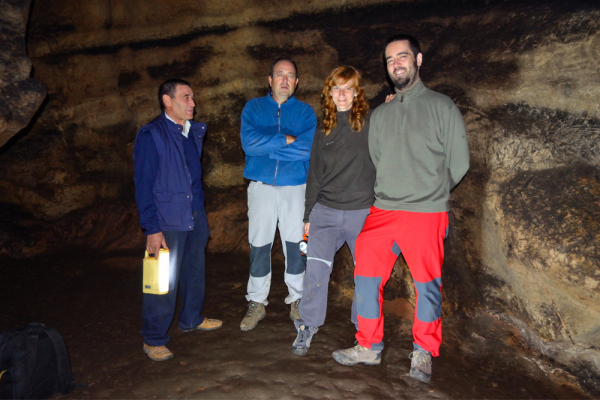UAH researchers find great discoveries in Los Casares cave
José Javier Alcolea González and Manuel Alcaraz Castaño are two prehistorians and archaeologists, professors of the UAH Prehistory Area, who since 2014 have resumed excavations and documentation of rock spellings in Los Casares cave, located in Riba de Saelices (Guadalajara).
These findings are allowing a significant number of cave paintings and engravings unknown to date, as well as a better understanding of the process of disappearance of Neanderthals inside the Iberian Peninsula.
This cave has been important for the knowledge of the ancient Prehistory of the interior of the Iberian peninsula since the beginning of the 20th century. Its archaeological importance was made known in the 1930s when Juan Cabré discovered a relevant series of engravings and paintings on the walls of Los Casares that could relate to what was already known as the rock ‘art’ of the Upper Paleolithic (between 42.000 and 11.000 years before the present).
A few years later, in the 1960s, Ignacio Barandiarán led several excavation campaigns inside the cavity, which uncovered, together with levels and materials of the recent Prehistory and medieval period, a settlement even older than cave paintings, in this case related to Neanderthal societies of the Middle Paleolithic (between 300,000 and 37,000 years before the present).In this place, we found utensils carved in stone, together with bone remains of herbivores and carnivores, as well as a metacarpal bone belonging to a Neanderthal. Thus the Paleolithic archaeological record that has led to the consideration of Los Casares cave was finished as one of the most relevant enclaves for the knowledge of the societies of hunter-gatherers of the upper Pleistocene, both Neanderthal and modern humans, inside the Iberian peninsula.
 |
| Trabajos de excavación arqueológica en la cueva de Los Casares, julio de 2019 |
Despite the scientific and heritage relevance that Los Casares have been recognized since then, it has not been until this decade that the research in the cavity has been resumed. The interdisciplinary team, led by Manuel and José Javier, has been developing since 2014 several research projects aimed both at the detailed study of the cave surveys and at the excavation of the archaeological deposits present in the interior cavernary.
The research developed in this cave is allowing to know better problems as relevant as those related to the causes of the disappearance of Neanderthals, the composition or the cultural context of Paleolithic ruptured graphs. Even the patterns of human settlement in the highlands of the Spanish Plateau are being discovered during the coldest phases of the last glaciation.
The results of the research of Los Casares are being very productive. On the one hand, detailed prospecting of the cavity walls, combined with graphic documentation including digital photography, photogrammetry, laser scanning and 3D modeling, is allowing a significant number of unpublished paintings and engravings to be documented and to characterize much more accurately the graphic repertoire known to date. New localized motifs include both abstract signs and new animal figures, including deer or horses, and even examples of less common species within the peninsula, such as reindeer, as well as some new anthropomorphic figures. In addition, Raman microscopy analyzes applied to the red and black strokes that make up the painted decorations have allowed to characterize the pigments used by paleolithic hunter-gatherers to decorate the cave.
On the other hand, excavations carried out in different areas of the interior of the cave have uncovered several stratigraphic sequences that reflect the human occupation of Los Casares throughout history, going back to a first settlement by Neanderthal societies during the Middle Paleolithic period.
The research carried out, and in particular the analysis of pollen remains, micromammals, burnt woods and phytoliths, has allowed to characterize the ecological context in which these hominines lived about 43.000 years ago, dominated by andscape and a temperate climate.
The subsequent deterioration of these ecological conditions, also recorded in the sediments preserved in the cavity, probably led to the abandonment of the place by these groups, perhaps contributing to the demographic processes that led to the disappearance of the Neanderthals as a species.
In addition, the last excavation campaign, carried out in the summer of 2019, identified a level of human occupation not known until then, which could be related to some of the decorating phases present in the cavity walls. This was precisely one of the objectives of the research, since to date the material remains of the human groups that carried out the cave surveys have not been located in the cave.
In any case, the direct relationship of this new level with these surveys is a hypothesis that must still be confirmed with the results of the carbon dating 14 carried out and, above all, new field data to be sought in the new excavation campaign beginning at the end of july.
‘This time it will be a special campaign due to the delicate health situation caused by the SARS-CoV-2 pandemic, so the working group will be reduced and we will maintain all the measures decreed, including the use of masks and the safety distance. We will also continue with the graphic documentation work on the walls of the cavity through digital photography and photogrammetry' according to archaeologists.
Los Casares cave can be visited by the general public, provided that the requirements for its conservation are kept. More information on the website of the City of Riba de Saelices.
Publicado en: Inglés
